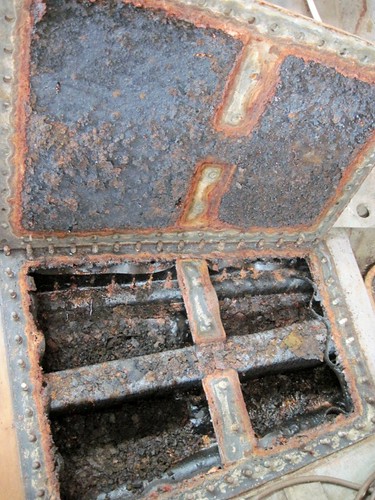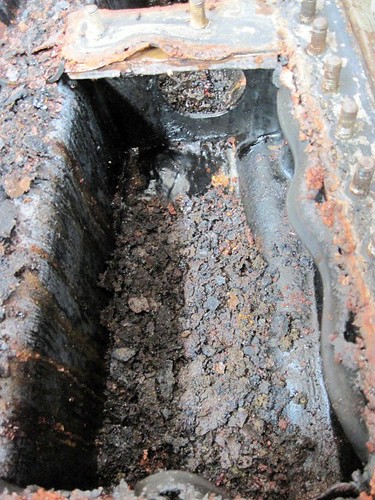949-Y, our boat, had the telltale stain at the hull keel joint on the aft edge. This was a symptom I was looking for when I surveyed the boat. These tanks are of course simply the fiberglass hull with a forward and aft bulkhead, flange around the top and steel cover plates bolted on. My boat has a sump just aft for the ice box drain. These large tanks(80 gallons from the day of gasoline engines and increased tankage demands) are baffled as well.
I often wonder if these large tanks were considered as a portion of the ballast as they are low in the keel and of course below the waterline. Maybe Bill can offer some insight on that point as his dad was involed in the design.
Neils Hellerberg at Alden advised me on how they approach the problem and here is a summary of what Alden prescribed:
Cut the tank tops off, cutting around the steel tops to leave the glass flange later for attaching floors for supporting the teak and holly sole later. Cut out baffles, grind, etc. and of course clean area to remove diesel residue.
Have two aluminum tanks built, about 20 gallons each to fit each side of the centerboard trunk. There may be space left over for a waste tank as well. Great idea.
Install new floors(framing) over plumbed tanks, soles next, done. A great idea and a big improvement to the boat. But I haven't done it yet, now five years later and here is why.
Contacting the previous yard, Burr Bros. in Mass. that cared for the boat for more than a decade, the yard foreman quickly affirmed the small oil stain at the aft edge of the keel. This boat was given carte blanche at the yard to perform what was needed. Every year they checked the water seperator and never found any. They were diligent about this.
As we know, this is not a pollution problem. Water pressure below the surface forces seawater into any opening in the tanks(or hull, result-sinking!). Water enters the diesel tank, runs through the seperator until it is full(of water) enters the injector pump and ruins the pump.
Burr Bros decided to quote "let sleeping dogs lie" and never saw water ingress.
I think one day I will perform the upgrade as it would be a great improvement but for now I'm leaving the dog alone.
Incidentlally, now I block the boat just aft of the keel joint and guess what, no diesel stain at the joint. Apparently, diesel being more viscous than water, found a tiny opening when the weight of the boat pushed the keel and of course a keel bolt, enough to allow this winter seepage of a few drops. In the water, the keel is of course hung from the boat closes the tiny opeing. I suspect most leaks could be atributed to the keel bolts but I would also suspect the centerboard trunk area as well. When they do leak, it sounds like it is difficult to find and repair and may be easier to convert to new tankage.
There are not many of us here yet but hopefully more tank experiences(and owners) will show up.
I often wonder if these large tanks were considered as a portion of the ballast as they are low in the keel and of course below the waterline. Maybe Bill can offer some insight on that point as his dad was involed in the design.
Neils Hellerberg at Alden advised me on how they approach the problem and here is a summary of what Alden prescribed:
Cut the tank tops off, cutting around the steel tops to leave the glass flange later for attaching floors for supporting the teak and holly sole later. Cut out baffles, grind, etc. and of course clean area to remove diesel residue.
Have two aluminum tanks built, about 20 gallons each to fit each side of the centerboard trunk. There may be space left over for a waste tank as well. Great idea.
Install new floors(framing) over plumbed tanks, soles next, done. A great idea and a big improvement to the boat. But I haven't done it yet, now five years later and here is why.
Contacting the previous yard, Burr Bros. in Mass. that cared for the boat for more than a decade, the yard foreman quickly affirmed the small oil stain at the aft edge of the keel. This boat was given carte blanche at the yard to perform what was needed. Every year they checked the water seperator and never found any. They were diligent about this.
As we know, this is not a pollution problem. Water pressure below the surface forces seawater into any opening in the tanks(or hull, result-sinking!). Water enters the diesel tank, runs through the seperator until it is full(of water) enters the injector pump and ruins the pump.
Burr Bros decided to quote "let sleeping dogs lie" and never saw water ingress.
I think one day I will perform the upgrade as it would be a great improvement but for now I'm leaving the dog alone.
Incidentlally, now I block the boat just aft of the keel joint and guess what, no diesel stain at the joint. Apparently, diesel being more viscous than water, found a tiny opening when the weight of the boat pushed the keel and of course a keel bolt, enough to allow this winter seepage of a few drops. In the water, the keel is of course hung from the boat closes the tiny opeing. I suspect most leaks could be atributed to the keel bolts but I would also suspect the centerboard trunk area as well. When they do leak, it sounds like it is difficult to find and repair and may be easier to convert to new tankage.
There are not many of us here yet but hopefully more tank experiences(and owners) will show up.





